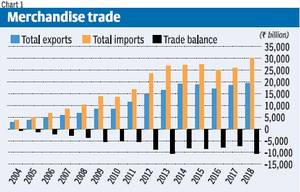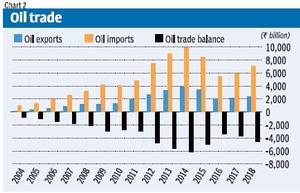What is the issue?
- The government’s fiscal deficit touched 114.8% of the full-year estimates at the end of November. Click here to know more.
- It is essential that the government wake up to other causes beyond the oil import impact.
What is the current trade scenario?
- India’s external account has once again emerged as a source of concern.
- Notably, the current account deficit has widened to reach 2.4% of GDP over April-June 2018.
- This increase was driven entirely by the trade deficit, which grew rapidly in 2017-18.
- Exports - Since 2014, exports have been mostly stagnant (after a period of healthy increases before then).
- But, total imports came down and then increased sharply in 2017-18.
- This was reflected in the total merchandise trade deficit.
- Trade deficit declined for several years from the large deficit observed in 2013-14, and only rose sharply once again in 2017-18.
- Over the period April-November 2018, the trade deficit is once again said to have widened.

How was the oil price impact?
- It is true that India benefited hugely from the global decline in oil prices in the first 4 years of current government's tenure.
- Evidently, the overall oil price scenario -
- reduced the pressure on the balance of trade
- contributed to lower rates of domestic inflation
- provided windfall gains to the public coffers
- Notably, the government did not pass on most of the oil price decline to consumers but instead raised tax rates.
- However, with India being net importer of oil, global oil prices have been suggested as the significant driver of the total trade deficit.
- Periods of rising global oil prices have therefore been associated with higher total imports and vice versa.
- So naturally, the external deficit is assumed to be driven by factors outside domestic policy control.
Is oil price the only factor for trade deficit?
- India is both an exporter and an importer of petroleum products.
- Also, there is growing involvement of domestic oil refinery and distribution corporations (particularly the private ones).
- Quite often, increased oil exports reflect the choices domestic oil companies make - to produce for the domestic market or to export.
- These, in turn, are related to the local prices and duties, therefore driven by domestic policy.
- The oil trade balance thus indicates that the oil deficit can increase even in periods of relatively low global oil prices (as in 2016-17).
- This is because of the choices made by Indian oil corporations, especially the private players like Reliance.
- So the impact of oil prices on balance of trade is not quite simple and is not driven only by external factors as it is believed to be.

What are the other factors?
- Non-oil imports have typically been high and rising rapidly.
- Even in the mid-2000s, non-oil trade was largely in balance and then began to show only relatively small deficits from 2006 onwards.
- After 2008, such deficits grew rapidly, as imports kept growing much faster than exports.
- Resultantly, the non-oil merchandise trade deficit peaked in 2012-13, ironically a time when global oil prices were also not that low.
- They came down the following year, but then rose once more, as non-oil imports kept expanding rapidly.
- It is to be noted that this increase was driven by increasing import volumes, as the prices for many of India’s imports also remained low.
- Low prices indicate that the potential of imports to displace domestic production has been much greater.
- Increased imports of various final goods have added to the woes of many small-scale producers in agriculture and industry.
- In all, even in the period of rise in oil prices in 2017-18, the non-oil trade deficit was even larger than the oil trade deficit.
What does it imply?
- High global oil prices are only one of the many reasons why India should be concerned about the rising external trade deficit.
- The more significant causes lie elsewhere, and some are domestic.
- The government should take note of this, and address the developments in non-oil imports too.
Source: Business Line

